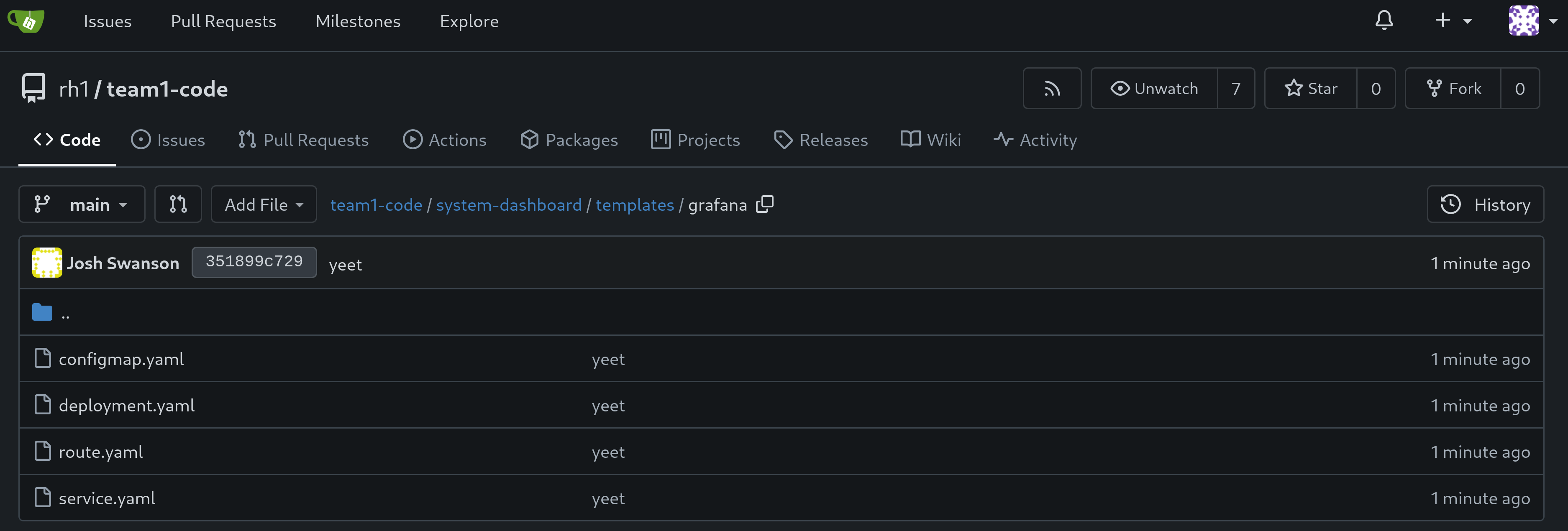Workshop Exercise 2.3 - Setting up Grafana
Table of Contents
- Objective
- Step 1 - Introduction to Grafana
- Step 2 - Creating a ConfigMap
- Step 3 - Creating a Deployment
- Step 4 - Adding a Service
- Step 5 - Adding a Route
- Step 6 - Save and Commit Code
Objective
- Get a brief introduction to grafana
- Setup a configuration for grafana
- Create deployment resources for an instance of grafana
Step 1 - Introduction to Grafana
Grafana is a visualization tool that can gather data from multiple sources and display it on dashboards. What makes it powerful is the flexibility of the system-dashboards themeselves, along with the ability to combine different types of data on a single system-dashboard.
Wer’re going to have grafana pull metrics our of our instance of prometheus, allowing us to craft a dashbaord that can be used to monitor the system.
Step 2 - Creating a ConfigMap
To setup grafana with some base configuration for our datasource from promtheus and to set the initial login credentials, we’ll need a configmap.
Similar to earlier exercises, create a new directory named grafana within our chart’s templates directory templates/, then add a file into the grafana directory named configmap.yaml with the following contents:
---
apiVersion: v1
kind: ConfigMap
metadata:
name: grafana-config
labels:
app.kubernetes.io/name: grafana
app.kubernetes.io/part-of: system-dashboard
data:
GF_SECURITY_ADMIN_USER: PICKAUSERNAME
GF_SECURITY_ADMIN_PASSWORD: PICKAPASSWORD
GF_DEFAULT_THEME: light
---
apiVersion: v1
kind: ConfigMap
metadata:
name: datasource-config
labels:
app.kubernetes.io/name: grafana
app.kubernetes.io/part-of: system-dashboard
data:
prometheus.yml: |
---
apiVersion: 1
deleteDatasources:
- name: Prometheus
orgId: 1
datasources:
- name: Prometheus
type: prometheus
access: proxy
orgId: 1
url: http://prometheus:9090
isDefault: true
version: 1
editable: true
Note:
Be sure to replace the username and password values with something memorable.
These two configmaps will set the initial credentials, as well as set up our instances of prometheus as a datasource.
Step 3 - Creating a Deployment
Next, we’ll want a deployment for grafana. Within the templates/grafana/ directory, add a new file named deployment.yaml with the following contents:
---
apiVersion: apps/v1
kind: Deployment
metadata:
name: grafana-deployment
labels:
app.kubernetes.io/name: grafana
app.kubernetes.io/part-of: system-dashboard
spec:
replicas: 1
selector:
matchLabels:
app.kubernetes.io/name: grafana
template:
metadata:
labels:
app.kubernetes.io/name: grafana
app.kubernetes.io/part-of: system-dashboard
spec:
containers:
- name: grafana
image: grafana/grafana-enterprise
resources:
limits:
memory: 256Mi
cpu: 500m
ports:
- name: port-3000
containerPort: 3000
envFrom:
- configMapRef:
name: grafana-config
volumeMounts:
- name: datasource-config
mountPath: /etc/grafana/provisioning/datasources
readOnly: true
volumes:
- name: datasource-config
configMap:
name: datasource-config
Within this deployment, our configmap will be mounted into the container where grafana will read it in on startup.
Step 4 - Adding a Service
Now, to enable communication with grafana, we’ll create a service. Create a new file named service.yaml within the templates/grafana directory with the following contents:
---
apiVersion: v1
kind: Service
metadata:
name: grafana
labels:
app.kubernetes.io/name: grafana
app.kubernetes.io/part-of: system-dashboard
spec:
selector:
app.kubernetes.io/name: grafana
ports:
- protocol: TCP
port: 3000
targetPort: 3000
The .spec.selector field ensures the service will attach to the correct pods.
Step 5 - Adding a Route
Since we’ll want to interact directory with Grafana, we’ll need a route to expose it from outside the cluster.
Add a new file named route.yaml to the templates/grafana/ directory with the following content:
---
kind: Route
apiVersion: route.openshift.io/v1
metadata:
name: grafana
labels:
app.kubernetes.io/name: grafana
app.kubernetes.io/part-of: system-dashboard
spec:
to:
kind: Service
name: grafana
port:
targetPort: 3000
tls:
termination: edge
Step 6 - Save and Commit Code
Ensure you’ve saved your edits if using the Gitea web interface, or committed/pushed if using an IDE.

Navigation
| Previous Exercise | Next Exercise |
